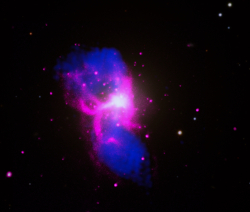 Hot as H
Hot as H
How quickly do black holes grow? Since black holes grow by accreting material from their surroundings (which increases both their mass, and their size), their rate of growth depends on how quickly material falls within the event horizon (the region of space and time from which nothing, not even electromagnetic radiation, escapes). The accretion process is complex, depending naturally on how much matter lies near the black hole, and the gravitational pull of the black hole compared to other forces which may be driving material away. Black holes are surprisingly messy eaters, expelling some fraction of the infalling matter in focussed, massive outflows, or jets, perpendicular to the accretion disk formed by the fight between gravitational and centrifugal forces on the infalling matter. These powerful jets can help curb the black hole's appetite by pushing material away from the black hole and allowing it to escape into space. The image above is a false-color multiwavelength view of the supermassive, accreting black hole in the active galaxy Messier 84. The black hole is located in the white region near the center of the image; jets from the black hole can be seen in blue, stretching toward the top and bottom of the image. X-ray emission (from the Chandra X-ray Telescope) in pink outlines extremely hot gas which forms a complex shape that resembles the letter H. The X-ray emission bounds dark regions with little X-ray emission, apparently evacuated by the powerful radio jets. Using these data, scientists have determined that, near the disk, the expected rate of matrial falling into the black hole is about what would be expected from simple gravitational accretion. But perpendicular to this direction, the accretion rate is only about one-hundredth of one percent of the expected value due to the effects of the outflowing jets, even very near the black hole.
NASA: 'H' is for Hot and Huge in Chandra Image
viewtopic.php?t=43109
| << Previous HEAPOW | High Energy Astrophysics Picture of the Week | Next HEAPOW >> |